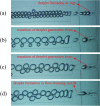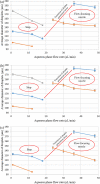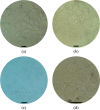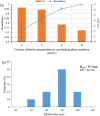Microfluidic on-chip production of microgels using combined geometries
- PMID: 33452407
- PMCID: PMC7810975
- DOI: 10.1038/s41598-021-81214-7
Microfluidic on-chip production of microgels using combined geometries
Abstract
Microfluidic on-chip production of microgels using external gelation can serve numerous applications that involve encapsulation of sensitive cargos. Nevertheless, on-chip production of microgels in microfluidic devices can be challenging due to problems induced by the rapid increase in precursor solution viscosity like clogging. Here, a novel design incorporating a step, which includes a sudden increase in cross-sectional area, before a flow-focusing nozzle was proposed for microfluidic droplet generators. Besides, a shielding oil phase was utilized to avoid the occurrence of emulsification and gelation stages simultaneously. The step which was located before the flow-focusing nozzle facilitated the full shielding of the dispersed phase due to 3-dimensional fluid flow in this geometry. The results showed that the microfluidic device was capable of generating highly monodispersed spherical droplets (CV < 2% for step and CV < 5% for flow-focusing nozzle) with an average diameter in the range of 90-190 μm, both in step and flow-focusing nozzle. Moreover, it was proved that the device could adequately create a shelter for the dispersed phase regardless of the droplet formation locus. The ability of this microfluidic device in the production of microgels was validated by creating alginate microgels (with an average diameter of ~ 100 μm) through an external gelation process with on-chip calcium chloride emulsion in mineral oil.
Conflict of interest statement
The authors declare no competing interests.
Figures






References
Publication types
LinkOut - more resources
Full Text Sources
Other Literature Sources

